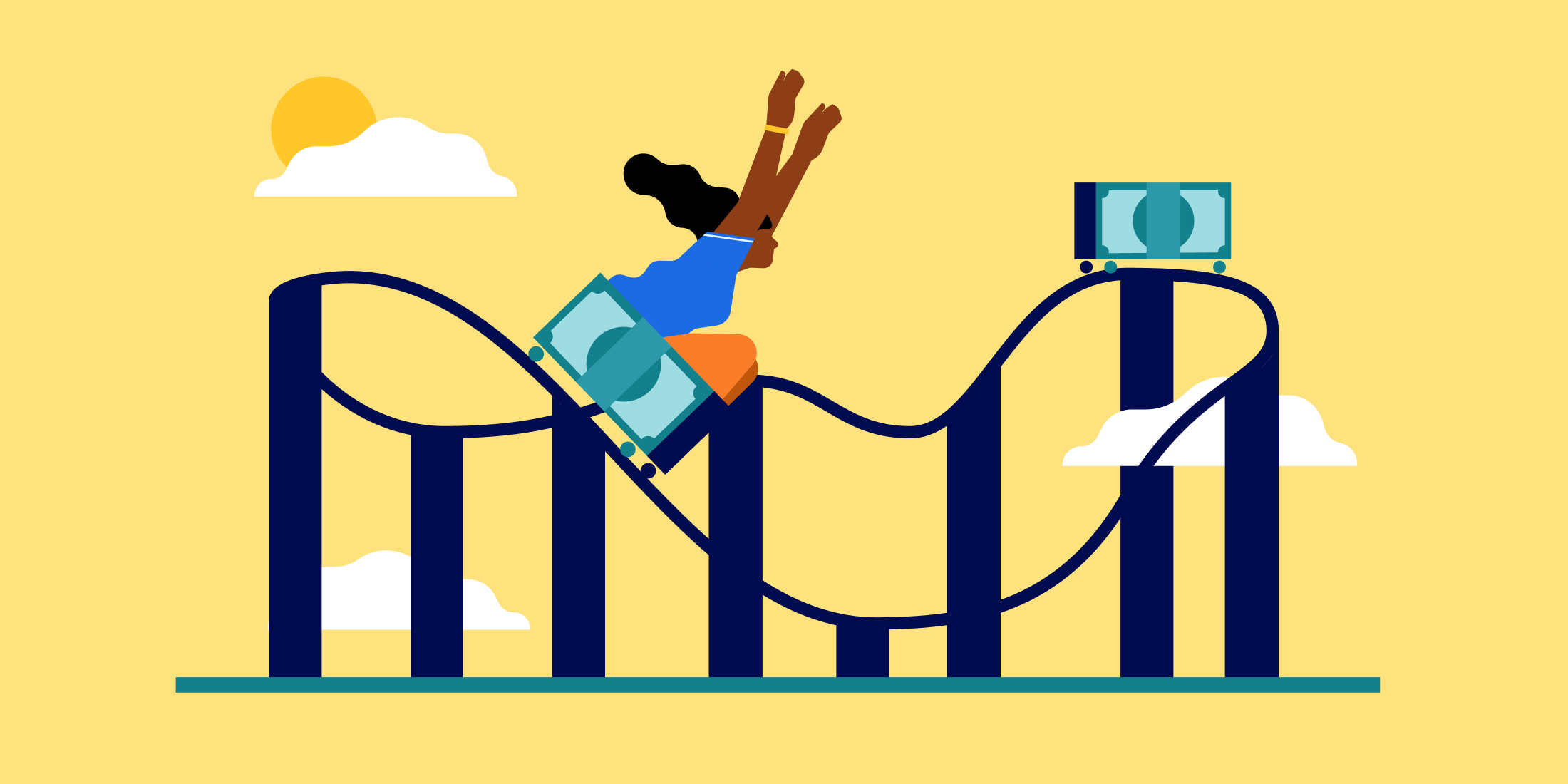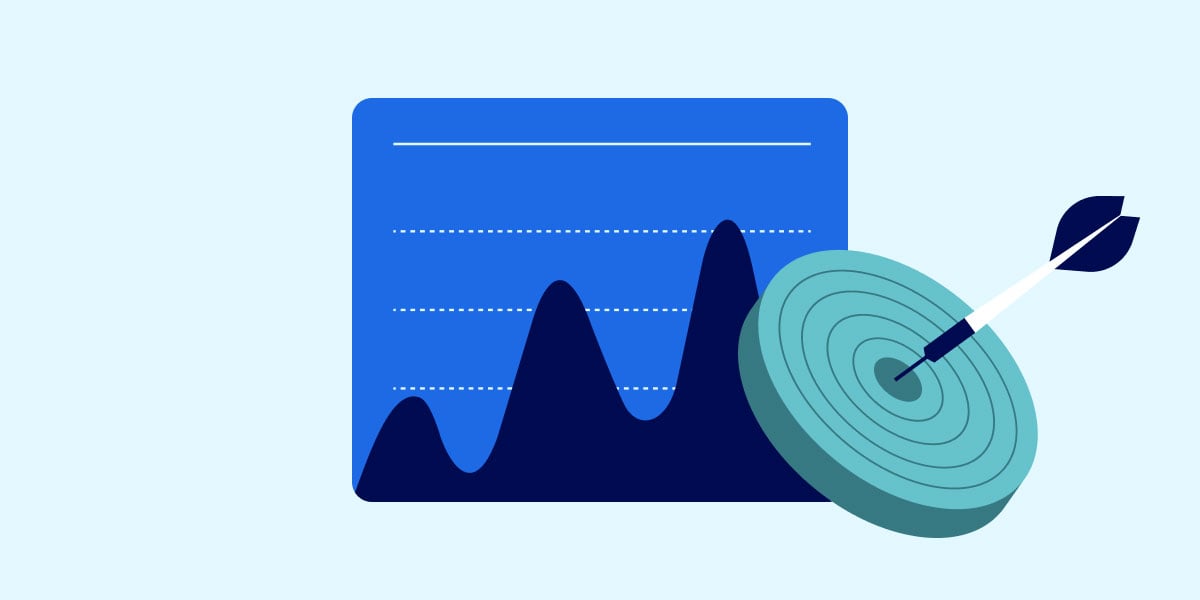Market Volatility

Featured articles
-
![]()
Making sense of market volatility
During times of market turbulence, it may be tempting to move your money to safer ground. But ...
Making sense of market volatility During times of market turbulence, it may be tempting to move your money to safer ground. But it’s important to consider the long-term impact of your decisions. As we've seen recently, the stock market can experience significant fluctuations, rising one day and declining the next. With market swings, tariff announcements, and policy changes flying about, you may be wondering what to do and whether now is the time to take action. You’ll hear from many financial advisors, including Betterment, that volatility is natural and often something you simply need to ride out. Which is true. While the temptation to move your money to safer ground is understandable, it’s important to consider the long-term impact of your decisions. You could miss out on growth opportunities or trigger a larger tax bill. Instead of taking immediate action, take a moment to think through your investing strategy, your financial needs, and potential next steps. Start with this question: When will I need my money? It’s impossible to time the market perfectly. But having a clear timeline for your financial goals allows you to prepare for volatile moments and even take advantage of them. A longer time horizon means you can afford to ride out downturns, while a shorter one may require different considerations. We’ll walk through four different scenarios based on time horizon and how you can align your volatility strategy with your financial goals. Staying invested at every stage in life If you’re not yet in the market: Waiting for the “perfect” time to invest often leads to missed opportunities. The best time to start is now, with a diversified portfolio that aligns with your goals. If you don’t need the money for decades: Whether we’re talking retirement, education savings, or just a healthy investing portfolio, if you’ve got decades to go, time is your greatest asset. Market volatility is normal, even if it feels chaotic. Staying invested and making consistent contributions over time will allow you to benefit from long-term growth and compounding. If you need the money in the next five to 10 years: Your investments still have time to recover from a downturn, but start thinking ahead. Make sure your portfolio reflects your risk tolerance while maintaining a focus on growth. As you get closer to your end goal, you may want to plan to shift toward a more conservative allocation of stocks to bonds, or even move money into a high-yield cash account. If you’re retired or nearly retired: In this retirement-specific case, you’re already drawing down on your investments (or will soon begin to). Remember that even though you’re “using” this money, you’ll be retired for a while, so you don’t want to miss out on growth entirely. “Have a plan that includes a mix of safe and growth-oriented investments. A cash or bond ‘bucket’ can cover short-term needs, while equities can support long-term growth,” says Betterment financial planner, Corbin Blackwell, CFP®. How Betterment can help you mitigate volatility While you can’t avoid market volatility altogether, you can take proactive steps to manage your money and financial needs during market downturns. Establishing a thoughtful investing strategy now will pay dividends in the future. Here are three things to consider as you determine your approach: Invest in a well-diversified portfolio: By investing in a diversified portfolio, your money isn’t riding the wave of any individual stock, asset type, or even a country’s performance. For example, the Betterment Core portfolio is globally diversified and has delivered 9.0% annual returns (after fees) since inception.1 Consider enabling tax loss harvesting: One silver lining strategy during market downturns is tax loss harvesting—a tax-saving tool that Betterment automates. TLH is the process of selling an asset at a loss (which can happen especially during market downturns) primarily to offset taxes owed on capital gains or income. Build and maintain an emergency fund: You should work to maintain 3-6 months of expenses. These funds should be stored in an account that’s relatively liquid but still can provide some level of growth to help keep up with inflation. Depending on your preferences for risk, growth, and liquidity, we offer a few options: Emergency Fund, our investment allocation built specifically for this use case, with 30% stocks and 70% bonds BlackRock Target Income, our 100% bond portfolios Cash Reserve, our 100% high-yield cash account Cash Reserve offered by Betterment LLC and requires a Betterment Securities brokerage account. Betterment is not a bank. FDIC insurance provided by Program Banks, subject to certain conditions. Learn more. The big picture If you remember nothing else, remember this: The most important thing you can do is avoid making rash decisions based on short-term market movement. Betterment is here with you every step of the way, helping ensure you make the most of your money, whether the market’s up or down. 1As of 12/31/2024, and inception date 9/7/2011. Composite annual time-weighted returns: 12.7% over 1 year, 7.9% over 5 years, and 7.8% over 10 years. Composite performance calculated based on the dollar-weighted average of actual client time-weighted returns for the Core portfolio at 90/10 allocation, net of fees, includes dividend reinvestment, and excludes the impact of cash flows. Past performance not guaranteed, investing involves risk. -
![]()
How to course correct when you simply can't stay the course
De-risking during market volatility can be costly. Here’s how to do it without breaking the ...
How to course correct when you simply can't stay the course De-risking during market volatility can be costly. Here’s how to do it without breaking the bank. The best course of action during market volatility is often inaction. That’s because selling riskier assets at a loss locks in those losses. It foregoes their potential for future growth, and it might also trigger capital gains taxes in the process. But if taking some sort of action feels necessary, then modestly reducing your overall risk exposure can be a reasonable alternative. Consider dialing down your existing stock allocation by a few percentage points, or lower the costs of recalibrating by using your future deposits instead. Either way, the solution may be the same: sprinkling in more bonds. Consider bonds to calm your investing nerves When people talk about diversification, equities like international stocks get most of the attention. But no less important in the role of managing risk are bonds. These are the loans given to governments and companies by investors, and while they're not completely risk-free (no asset is), the relatively-modest interest they tend to pay out can feel like a windfall when stock values are plunging. They won’t negate all of the volatility of stocks, but they can help smooth things out and preserve capital. This is why all of our recommended allocations include holding at least some bonds. One way to de-risk some of your future investing is with one of our portfolios made up of both stocks and bonds (Core, Value Tilt, etc.). We’ll recommend a risk level based on your goal, but we make it easy to dial up the bond allocation to your preference. Over time, you can slowly finetune things until your collective risk feels right. Or you can let us automatically adjust it based on your target date. We also offer two portfolios comprised entirely of bonds, each one designed for a different use: The BlackRock Target Income portfolio, designed to help you limit market volatility, preserve wealth, and generate income. The Goldman Sachs Tax-Smart Bonds portfolio, designed for high-income individuals seeking a higher after-tax yield compared to a cash account. Don’t forget about the role of cash One of the best ways to mitigate your overall financial risk is by shoring up your emergency fund, which may include a high-yield cash account like our Cash Reserve. Imagine losing your income stream, and how much time you'd want to get back on your feet. A good place to start is 3-6 months' worth of your essential expenses, but your right amount is whatever helps you sleep more soundly at night. Cash Reserve offered by Betterment LLC and requires a Betterment Securities brokerage account. Betterment is not a bank. FDIC insurance provided by Program Banks, subject to certain conditions. Learn more. Steadying the ship during unsteady times As we mentioned up front, right-sizing your risk during downturns isn’t always cheap. But there are ways to minimize the costs. Lowering your risk profile incrementally is one of them, and stretching out your safety net is another. Either way, it’s okay to recalibrate your risk tolerance from time-to-time, and you can do it wisely with Betterment. -
![]()
Four keys to riding the market's ups and downs
Let time work in your favor. Let the market worry about itself.
Four keys to riding the market's ups and downs Let time work in your favor. Let the market worry about itself. Financial markets are unpredictable. No matter how much research you do and how closely you follow the news, trying to “time the market” usually means withdrawing too early and investing too late. In this guide, we’ll explain: Why a long-term strategy is often the best approach The problems with trying to time the market How to accurately evaluate portfolio performance How to make adjustments when you need to Why a long-term strategy is often the best approach Watch the market closely, and you’ll see it constantly fluctuate. The markets can be sky high one day, then come crashing down the next. Zoom in close enough on any ten-year period, and you’ll see countless short-term gains and losses that can be large in magnitude. Zoom out far enough, and you’ll see a gradual upward trend. It’s easy to get sucked into market speculation. Those short-term wins feel good, and look highly appealing. But you’re not trying to win the lottery here—you’re investing. You’re trying to reach financial goals. At Betterment, we believe the smartest way to do that is by diversifying your portfolio, making regular deposits, and holding your assets for longer. Accurately predicting where the market is going in the short-term is extremely difficult, but investing regularly over the long-term is an activity you can control that can lead to far more reliable performance over time. The power of compounding is real. By regularly investing in a well-diversified portfolio, you’re probably not going to suddenly win big. But you’re unlikely to lose it all, either. And by the time you’re ready to start withdrawing funds, you’ll have a lot more to work with. The basics of diversification Diversification is all about reducing risk. Every financial asset, industry, and market is influenced by different factors that change its performance. Invest too heavily in one area, and your portfolio becomes more vulnerable to its specific risks. Put all your money in an oil company, and a single oil spill, regulation, lawsuit, or change in demand could devastate your portfolio. There’s no failsafe. The less you lean on any one asset, economic sector, or geographical region, the more stable your portfolio will likely be. Diversification sets your portfolio up for long-term success with steadier, more stable performance. The problems with trying to time the market There are two big reasons not to try and time the market: It’s difficult to consistently beat a well-diversified portfolio Taxes Many investors miss more in gains than they avoid in losses by trying to time a dip. Even the best active investors frequently make “the wrong call.” They withdraw too early or go all-in too late. There are too many factors outside of your control. Too much information you don’t have. To beat a well-diversified portfolio, you have to buy and sell at the perfect time. Again. And again. And again. No matter how much market research you do, you’re simply unlikely to win that battle in the long run. Especially when you consider short-term capital gains taxes. Any time you sell an asset you’ve held for less than a year and make a profit, you have to pay short-term capital gains taxes. Just like that, you might have to shave up to 37% off of your profits. With a passive approach that focuses on the long game, you hold onto assets for much longer, so you’re far less likely to have short-term capital gains (and the taxes that come with them). Considering the short-term tax implications, you don’t just have to consistently beat a well-diversified, buy-and-hold portfolio. In order to outperform it by timing the market, you have to blow it out of the water. And that’s why you may want to rethink the way you evaluate portfolio performance. How to evaluate portfolio performance Want to know how well your portfolio is doing? You need to use the right benchmarks and consider after-tax adjustments. US investors often compare their portfolio performance to the S&P 500 or the Dow Jones Industrial Average. But that’s helpful if you’re only invested in the US stock market. If you’re holding a well-diversified portfolio holding stocks and bonds across geographical regions, a blended benchmark that consists of global stocks such as MSCI ACWI Index and global bonds using Bloomberg Barclays Global Aggregate Bond Index may be a better comparison. Just make sure you compare apples to apples. If you have a portfolio that’s 80% stocks, don’t compare it to a portfolio with 100% stocks. The other key to evaluating your performance is tax adjustments. How much actually goes in your pocket? If you’re going to lose 30% or more of your profits to short-term capital gains taxes, that’s a large drain on your overall return that may impact how soon you can achieve your financial goals. How to adjust your investments during highs and lows At Betterment, we believe investors get better results when they don’t react to market changes. On a long enough timeline, market highs and lows won’t matter as much. But sometimes, you really do need to make adjustments. The best way to change your portfolio? Start small. Huge, sweeping changes are much more likely to hurt your performance. If stock investments feel too risky, you can even start putting your deposits into US Short-Term Treasuries instead, which are extremely low risk, highly liquid, and mature in about six months. This is called a “dry powder” fund. Make sure your adjustments fit your goal. If your goal is still years or decades away, your investments should probably be weighted more heavily toward diversified stocks. As you get closer to the end date, you can shift to bonds and other low-risk assets. Since it’s extremely hard to time the market, we believe it’s best to ride out the market highs and lows. We also make it easy to adjust your portfolio to fit your level of risk tolerance. It’s like turning a dial up or down, shifting your investments more toward stocks or bonds. You’re in control. And if “don’t worry” doesn’t put you at ease, you can make sure your risk reflects your comfort level.
Considering a major transfer? Get one-on-one help with one of our experts. Explore our licensed concierge
All Market Volatility articles
-
![]()
A big bill, ballooning debt, and a weakening U.S. dollar
A big bill, ballooning debt, and a weakening U.S. dollar Aug 20, 2025 5:00:00 AM The “Big Beautiful Bill” could take our national debt to unseen levels. Will international markets reap the rewards? In early July, Congress passed the One Big Beautiful Bill Act (OBBBA), and while its full impact won’t be felt for some time, two key aspects of it seem at odds. The first is that it permanently extends certain provisions of the 2017 Tax Cuts and Jobs Act, including lower individual tax rates and higher standard deductions. The similar corporate and individual income boosting nature of the OBBBA has likely played some part in the rally in stocks since April. Yet as much as markets eat this type of legislation up, it comes with a strong risk of heartburn. That’s because the second major takeaway from the bill is that it’s forecasted to add around $4 trillion to the national debt over the next 10 years. The chart below shows the national debt as a share of U.S. GDP, and the dashed orange line shows the estimated trajectory after the passage of the OBBBA. It’s projected to grow to levels unlike anything we’ve seen before, including World War II. So what does all this mean for markets? Burgeoning debt means a larger supply of Treasury bonds that the Federal government uses to borrow. This may in turn cause interest rates to rise in the long term as bond investors with creeping doubts about our country’s fiscal situation demand a lower price and a higher yield for its debt. There are also estimates that the bill may be a drag on economic growth as bigger deficits and government borrowing start to crowd out private investment. We may not fully know the outcomes of tariffs and the OBBBA for some time, but one place we’re seeing policy changes already is in demand for the U.S. dollar. Since January, we've seen a significant weakening in the dollar relative to other major currencies as the trade war and fiscal outlook have shaken confidence in U.S. markets. The dollar is down almost 10% over the last six months, the largest decline in such a span in over 30 years. A weaker dollar has the effect of making imports in the U.S. more expensive for consumers, but it also makes international investments worth more, as the values of companies overseas have gone up in dollar terms just by virtue of their local currencies strengthening relative to the dollar. This currency dynamic has contributed to the strong returns of our globally-diversified portfolios in 2025. The first half of the year offers a case study in the benefits of being globally-diversified, which smooths out volatility as various parts of the world take turns outperforming each other. It may not make the news headlines any less scary, but it can benefit your investing’s bottom line. Cash Reserve offered by Betterment LLC and requires a Betterment Securities brokerage account. Betterment is not a bank. FDIC insurance provided by Program Banks, subject to certain conditions. Learn more. -
![]()
Inside the investing kitchen, part 3
Inside the investing kitchen, part 3 Aug 15, 2025 12:00:00 PM Order up! See how we handle thousands of trades each day to keep customers’ portfolios humming. When a chef plates a meal, they typically send it off, never to be seen again. But serving up an investing portfolio is an ongoing affair. Deposits come in. Withdrawals go out. Asset classes grow and shrink as the market moves. Rebalancing takes place on the regular. All of this requires daily trading. And this buying and selling of securities is among the most intricate and highly-regulated pieces of our operations. So while the first two parts of this series cover the recipes and ingredients behind our investing, our final course focuses on the team—and tech—behind every transaction. What happens when you hit "deposit" Cara Daly is an adventurer at heart. An avid surfer and the daughter of a flight attendant, she racks up air miles chasing waves and visiting family in Ireland. So naturally, she's gravitated toward one of the more thrill-seeking roles on our Investing team: Capital Markets. From the minute markets open each day, Cara and team monitor the action, making sure our customers' orders go smoothly. These trades can amount to hundreds of millions of dollars in a single day, and the system that executes them all is in many ways our secret sauce. It's custom-built (a rarity in the industry) and plays the role of Mission Control. When a customer clicks "deposit," for example, that single click gets translated into a series of purchases. These in turn get bundled up with other purchases of a like-kind and turned into orders, which are then executed at calibrated intervals as a part of our managed trading strategy. This sort of intentional trading is incredibly important because of the scale of our operations. We manage $65 Billion+ of assets, making us the largest independent robo-advisor out there. We may not "make" markets, but our trading volume is big enough to potentially influence them. So we need to be mindful of how and when our trades get executed. “Say the market trades $10 million of a hypothetical security on any given day,” Cara says. “If our customers happen to want $20 million of it, meeting all that demand without minding the bigger context could drive up the price.” To navigate these executional challenges, we deploy multiple strategies as needed (see below for a few examples), evaluating and calibrating each on a continuous basis. Taken altogether, they help ensure our customers' purchases and sales get treated fairly in the market. Waiting out the first half hour after markets open before starting our trading. This helps sidestep some of the volatility that's common early in the day. Trading periodically throughout the day, and randomizing when customers’ orders are processed. It's possible that prices can loosely correlate with certain times of the day, so we don't want that to consistently affect any one customer. Briefly holding back on “system-generated” trading (proactive rebalancing, for example) for any particular fund if its trading reaches a certain threshold relative to its average daily volume. This helps make sure “user-directed” trading (when customers make deposits or withdrawals, to name a few examples) can continue regardless. Partnering with industry experts like Apex to route and execute orders across multiple firms, helping us stay at the forefront of the evolving market landscape. This access to different execution venues also helps seek out the most favorable terms for customers—whether that’s price, speed, or overall execution quality. Switching gears from execution to tax optimization, we also use both primary and secondary funds for most of our asset classes. These backup “tickers” come into play during times of heightened volatility in markets. Moments that can make or break an investing strategy. Acing the stress test of market volatility More often than not, it's business as usual on our Capital Markets team, and that's by design. But during stretches of extreme volatility, when trading volume really picks up and prices can swing wildly from hour to hour, it's all hands on deck. Cara and company monitor our trading system for signs that additional oversight may be needed. They ease emerging bottlenecks in real time and keep things running smoothly, at times enlisting the support of our Trading Engineering team. Cara Daly (left) helps make sure customers’ daily trading goes smoothly. Take April of 2025 for example. Early in the month, the Trump administration caught investors off guard by announcing a series of tariffs way higher and way earlier than expected. The announcement, and the inconsistent messaging that followed, set off a wild, weeks-long stretch of trading. Prices of some securities cratered in the morning only to recover by day's end. Our systems not only weathered this storm, but capitalized on it, taking advantage of small windows of time to harvest tens of millions of dollars in temporary losses for customers before prices recovered. This strategy of tax loss harvesting helps sprinkle tax advantages on a portion of customers' taxable investing, and it wouldn’t be possible without the help of those aforementioned secondary tickers. These funds help reduce “wash sales” while maintaining customers’ desired exposures and risk levels. Betterment does not provide tax advice. TLH is not suitable for all investors. Learn more. Something delicious is simmering The image of a golden harvest is an apt one, considering this series looks at our Investing team's work through a culinary lens. Many of our customers come to us not necessarily for a single serving of returns, but to plant the seeds for self-sustaining, long-term wealth. A harvest that supports a more-fulfilling life. Cara and the rest of our Capital Markets experts are a big part of that lifecycle, tending to thousands of daily trades that optimize our customers’ portfolios over and over again. That's the beauty of using technology as a tool to expand our own capabilities and deliver results at scale. It's a people-led process. We became a trusted leader in automated money management not because of our tech, but because of the people who build and use it each day. Specialists like Cara, Josh, and Jamie—They're our secret ingredient, working in service of customers hungry for a better way to invest. Bon appétit. -
![]()
How we make market downturns less scary
How we make market downturns less scary Apr 7, 2025 12:12:58 PM And how it can benefit your investing’s bottom line. The recent round of tariffs and trade wars have roiled markets, offering the latest example of investing’s inherent volatility. The fact that market drops do happen, and happen with some regularity, means that managing them is not only possible but paramount. "It's not about whether you're right or wrong," the investor George Soros once quipped. "But how much money you make when you're right, and how much you lose when you're wrong." Mitigating losses, in other words, matters just as much as maximizing gains. And this is true for two important reasons: The bigger the loss, the more tempted you may be to sell assets and lock in those losses. The bigger the loss, the less fuel for growth you have when the market does rebound. Point A is psychological, while Point B is mathematical, so let’s take each one separately. In the process, we’ll explain how we build our portfolios to not only weather the storm, but soak up as many rays as possible when the sun shines again. Smoothing out your investing journey Imagine you’re given a choice of rides: one’s a hair-raising roller coaster, the other a bike ride through a series of rolling hills. Sure, thrill seekers may choose the first option, but we think most investors would prefer the latter, especially if the ride in question lasts for decades. So to smooth things out, we diversify. Owning a mix of asset types can help soften the blow on your portfolio when any one particular type underperforms. Our Core portfolio, for example, features a blend of asset types like U.S. stocks and global bonds. The chart below shows how those asset types have performed individually since 2018, compared with the blended approach of a 90% stocks, 10% bonds allocation of Core. As you can see, Core avoids the big losses that individual asset classes experience on the regular. That’s one reason why through all the ups and downs of the past 15 years, it’s delivered 9% composite annual time-weighted returns1, and that’s after fees are accounted for. 1As of 12/31/2024, and inception date 9/7/2011. Composite annual time-weighted returns: 12.7% over 1 year, 7.9% over 5 years, and 7.8% over 10 years. Composite performance calculated based on the dollar-weighted average of actual client time-weighted returns for the Core portfolio at 90/10 allocation, net of fees, includes dividend reinvestment, and excludes the impact of cash flows. Past performance not guaranteed, investing involves risk. Core’s exposure to global bonds and international stocks has also helped its cause, given their outperformance relative to U.S. stocks year-to-date amidst the current market volatility of 2025. A smoother ride can take your money farther Downside protection is all the more important when considering the “math of losses.” We’ll be the first to admit it’s hard math to follow, but it boils down to this: as a portfolio’s losses rack up, the gains required to break even grow exponentially. The chart below illustrates this with losses in blue, and the gains required to be made whole in orange. Notice how their relationship is anything but 1-to-1. This speaks to the previously-mentioned Point B: The bigger your losses, the less fuel for growth you have in the future. Investors call this “volatility drag,” and it’s why we carefully weigh the risk of an investment against its expected returns. By sizing them up together, expressed as the Sharpe ratio, we can help assess whether the reward of any particular asset justifies its risk. This matters because building long-term wealth is a marathon, not a race. It pays to pace yourself. And yet, there will still be bumps in the road Because no amount of downside protection will get rid of market volatility altogether. It’s okay to feel worried during drops. But hopefully, with more information on our portfolio construction and automated tools like tax loss harvesting, you can ride out the storm with a little more peace-of-mind. And if you’re looking for even more reassurance, consider upgrading to Betterment Premium and talking with our team of advisors. -
![]()
Three burning questions for the market in 2025
Three burning questions for the market in 2025 Jan 7, 2025 10:09:29 AM Are U.S. stocks overvalued? Will AI pan out? Do markets care who’s in the White House? Investors are starting to feel a healthy dose of cognitive dissonance—that grating feeling when two beliefs you hold don't quite line up. On one hand, the U.S. market is soaring on the back of AI optimism and potential tax cuts. And on the other, companies’ stock prices, relative to their actual earnings, are starting to loosely resemble the run-up to the Dotcom bubble of the late 90s. So which belief will win out in 2025: boom or bust? Let's parse this conflicted outlook by examining three questions in particular: Are U.S. stocks overvalued? Will AI pan out? Do markets care who’s in the White House? Are U.S. stocks overvalued? Around this time last year, we said the booming market at the time might keep going if the Fed lowered interest rates in response to cooling inflation. Interest rates did tick down, and boy, did markets take notice. Through the end of November 2024, a 90% stock Betterment Core portfolio returned roughly 17.6% year-to-date. Such a run, however, begs speculation of yet another reversal, a swing of the pendulum toward less frothy valuations and a drawback in portfolio returns. The S&P 500 currently costs about 25 times more than what those companies are expected to bring in over the next 12 months. For comparison, this average “price-to-earnings” ratio over the last 35 years has been 18x. Taking the perspective of a long-term investor, however, these ratios matter less than you may think. So long as you stay invested for more than a few years, chances are the market as a whole may “grow” into its valuation. Remember 2021 when a group of tech-centric, risky stocks were darlings of the pandemic and shot to the moon? Analysts rightly called foul—those kinds of valuations shouldn’t be sustainable. But within a few years the market was setting fresh all-time highs. An investor who had sold or stayed on the sidelines would've missed out on all that growth. So if you’re tempted to sell “high” right now, remember this: On average, investing at all-time highs hasn’t resulted in lower future returns compared to investing on any given trading day. On the contrary, buying when the market has never been higher leads to slightly higher average returns in the long run. You can never be sure exactly when a growth cycle will end. Will AI pan out? A big driver of this bull market has been optimism surrounding artificial intelligence and the big tech companies powering it, like Amazon, Google, and the computer chip-maker Nvidia. They’ve rallied big-time over the last 12 months, and as a result, they make up an increasingly large share of the U.S. and global stock market. A debate, however, surrounds their outperformance and the hoopla around AI in general. Some analysts argue that a good amount of AI investment won’t ultimately prove fruitful, while others foresee significant boosts to productivity and profits. There’s that grating feeling again—the potential of revolutionary upside sitting right next to worries that it’s mostly hype. In the face of uncertainty, all one can do to lower their risk is hedge their bets and diversify. Our portfolios’ stock allocations take this to heart, offering significant exposure to Big Tech, while also investing in European, Japanese, and emerging markets. It’s these less expensive equities that provide a potential buffer in the event AI’s ambitions fall short. Do markets care who’s in the White House? Right now, markets aren’t sure exactly what to make of President-elect Trump’s proposed economic agenda. Promises of corporate tax cuts, while fueling the recent surge in stocks, could in practice increase inflation. Same goes for tariffs and mass deportation. And rising inflation could in turn pause or reverse the recent trend in interest rate cuts. But until more details emerge, or the policies themselves are actually put into practice, we won’t know their full effect. Instead of sitting back and anxiously waiting, we suggest taking a look at the chart below. It shows that markets tend to rise over time regardless of which party holds the presidency. Maintaining a consistent, diversified investment approach is the best way to navigate political and economic cycles. That, and maybe cooling it a bit on your news consumption. So what now? As always, it’s impossible to know exactly how long each growth cycle will last, so consider erring on the side of staying invested. If you find yourself sitting on too much cash, now might be the time to put it to work in the market. You can invest it as a lump sum, which research shows may offer higher potential returns. Or you can sprinkle it into a portfolio over time. Most importantly, however the market performs in 2025, we suggest zooming out and reminding yourself you’re in it for the long haul. -
![]()
An investor's guide to market volatility
An investor's guide to market volatility Nov 1, 2024 6:00:00 AM Knowing what to do during a market downturn can be especially difficult in the moment. Here’s how to plan ahead. In 1 minute When the prices in financial markets change, that’s market volatility. More volatility means greater potential for both gains or losses. In investing, market volatility comes with the territory. Some days the market is up, and other days it’s down. It’s OK to be anxious during a dip, but preparing for market volatility can help you avoid making decisions out of fear. Two of the biggest ways you can prepare for volatility: Diversify your portfolio Build an emergency fund Diversification helps protect your portfolio by spreading out your risk. A diversified portfolio may not gain as much as some individual assets, but it likely won’t lose as much as others. An emergency fund is a financial safety net. If market volatility negatively impacts your investments, your emergency fund can help cover your expenses until the economy recovers. During a downturn, we recommend resisting the urge to change your investments. Give your portfolio time to recover. But if you can’t do that, try to keep changes small, like lowering your stock allocation so that it’s more consistent with a more conservative risk tolerance level. In general, you should invest for the long-term, but at the same time you’ll likely want a diversified portfolio that you’re comfortable holding on to even when things in the market get bad. This can increase the odds you remain in the market when it ultimately recovers and continues on its path of expected long-term growth. Still not satisfying the itch to act? High management fees or capital gains distributions (from a mutual fund) could make that market volatility more uncomfortable. Or perhaps your financial advisor isn’t sticking to your target allocation as your portfolio experiences gains and losses. In these situations, a lower-fee robo-advisor like Betterment can help alleviate that discomfort. In 5 minutes In this guide, we’ll cover: What market volatility is How to prepare for it What to do about it Nobody likes to see their finances take a nosedive. But in a volatile market, dips happen often. Market volatility refers to fluctuations in the price of investments. Some markets—like the stock market—fluctuate more than others. And in times of economic stress, markets tend to be even more volatile, so you might see some big ups and downs. It’s tempting to sell everything and bail out during dips, but that often does more harm than good. Selling your assets could lock-in losses before they have a chance to rebound from the dip, and it’s nearly impossible to predict the market’s high points and low points. Reacting to market drawdowns by moving to cash is like selling your clothes because you gained a few pounds. Sure, they may feel a little snug, but you could find yourself with a bare closet if and when your weight fluctuates the other way. Historically, the stock market has had plenty of bad days. In any given decade, you’re bound to see many drawdowns, where investment values dip frightfully low. But when you step back and look at the big picture, the market has trended upward over time. So far, the global stock market, and by extension the U.S. stock market, has always recovered from economic downturns. And while nothing in life is guaranteed, those are some pretty good odds. History shows us that experiencing short-term losses is part of the path to long-term gains. The key for investors is to expect market volatility. It’s inevitable. And that means you need to prepare for it—not simply react to it. How to prepare for market volatility Market volatility can occur at any time. So you want to be ready for it now and in the future. The main thing you can do to prepare is diversify your portfolio. Having a balance of different assets decreases your overall level of risk. While some of your assets momentarily struggle, for example, others may hold steady or even thrive. The goal is your portfolio will hopefully feel less like a rollercoaster and more like a fun hike up wealth mountain. Beyond that, you’ll want to strongly consider building an emergency fund. A good starting point is having enough to cover three to six months of expenses. This is money you want on hand if market volatility takes a turn for the worse. Even if you don’t depend on your investments for income, major economic downturns can affect your life in other ways. The poor economy could lead to layoffs, bankruptcies, and other situations that impact your job stability. Or if you have rental properties, the real estate market could be adversely affected as well. All the more reason to have an emergency fund and ride out that turbulence if the need arises. What investors should do during downturns Caught in a downturn? Don’t panic. Seriously, when the market looks grim, the best reaction is usually to do nothing. Selling off your portfolio to prevent further losses is a common investor mistake that does two things: It locks-in those losses It takes away your chance to rebound with the market Scratching an itch usually won’t prevent it from recurring. The same goes for reacting to short-term losses in your portfolio. As much as you can, you want to resist the urge to react. Still, sometimes you may feel like you have to make a change. If that’s you, the first thing to do is make sure you’re comfortable with the level of risk you’re taking. Some asset classes, like stocks, are more volatile than others. The more weighted your portfolio is toward these assets, the more vulnerable it is to changes in the market. You’ll also want to confirm that your time horizon (when you need the money) is still correct. Think of this like checking your pulse, or taking a few deep breaths. You’re making sure your investments look right—that everything is working like it’s supposed to. If you’re still feeling tempted to do something drastic like withdraw all your investments, you probably should reduce your level of risk. Even if everything looks right for your goals, making a small adjustment now could prevent you from making a bigger mistake out of panic later. Your pulse is too high. Your breaths are too rapid. Sitting at 90% stocks and 10% bonds? You might try dialing it down to 75% stocks and 25% bonds. The time may be ripe to consider a Roth conversion Our investing advice of doing nothing and staying the course is generally the direction we try to nudge you toward when markets are down. While drops in global markets can be stressful, they also provide opportunities that can be beneficial for future you. One of those strategies is implementing a Roth conversion. A Roth conversion allows you to transfer, or convert, funds from a traditional IRA to a Roth IRA. You will typically owe income taxes on the amount you convert in the year of conversion, but the tradeoff is that once inside the Roth IRA future growth and withdrawals are generally tax-free. You can take a look at other pros and cons of Roth conversions in our Help Center. Here are a couple of reasons why you may want to consider converting your IRA when the market is down: The balance of your Traditional IRA has dropped significantly. When the balance of your Traditional IRA drops, you’re able to convert the same number of shares at lower market prices. This means you may pay less in taxes than if you converted those same number of shares at higher market prices. Growth from a global market recovery can be better in a Roth IRA than a Traditional IRA. As global markets recover over time, the value of your converted holdings may increase. This increase in value will now take place in your Roth IRA. Down the line, when you start taking withdrawals out of your Roth IRA in retirement, you’ll be able to do so without incurring any taxes. To understand how a Roth conversion may impact your personal financial situation, we strongly recommend consulting a tax advisor and IRS Publication 590. Reassess where you invest Depending on your situation, another option might be to shift your investments to a financial institution like Betterment. This could save you money in other ways, which might make your current risk level feel more comfortable. Some signs this might be the right move for you: 1. Your accounts have higher management fees You can’t control how the market performs, but you don’t have to be stuck with higher fees. Switching to a lower-fee institution like Betterment could lead to less of a drag on your long-term returns. 2. Your allocation is incorrect The sooner you need to use your money, the less risk you should take. Not sure what level of risk is right for you? When you set up a financial goal with Betterment, we’ll recommend a risk level based on your time horizon and target amount. 3. You own mutual funds that pay capital gains distributions When a mutual fund manager sells underlying investments in the fund, they may make a profit (capital gains), which are then passed on to individual shareholders like you. These distributions are taxable. Even worse: mutual funds can pay out capital gain distributions even if the fund’s overall performance is down for a year. So in a volatile market, your portfolio could lose value and you may still pay taxes on gains within the fund. In contrast, most exchange traded funds (ETFs) are more tax efficient.
Looking for a specific topic?
- 401(k)s
- 529s
- Asset types
- Automation
- Benchmarks
- Bonds
- Budgeting
- Compound growth
- Costs
- Diversification
- Donating shares
- ETFs
- Education savings
- Emergency funds
- Financial advisors
- Financial goals
- Flexible portfolios
- Getting started investing
- Health Savings Accounts
- Home ownership
- IRAs
- Interest rates
- Investing accounts
- Market volatility
- Mutual funds
- Performance
- Portfolios
- Preparing to retire
- Retirement income
- Retirement planning
- Risk
- Rollovers and transfers
- Roth accounts
- Stocks
- Tax Coordination
- Tax loss harvesting
- Taxable accounts
- Taxes
No results found








